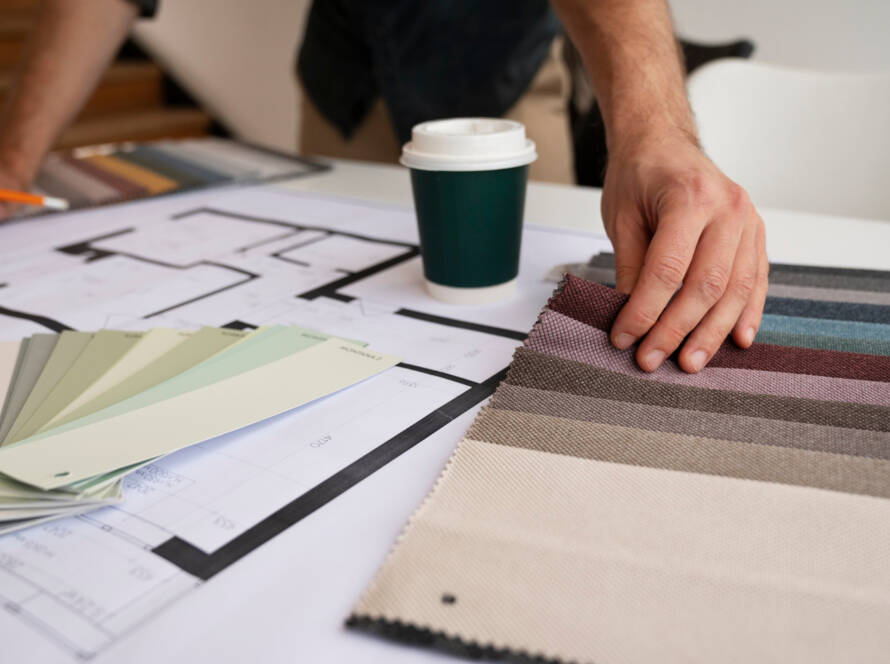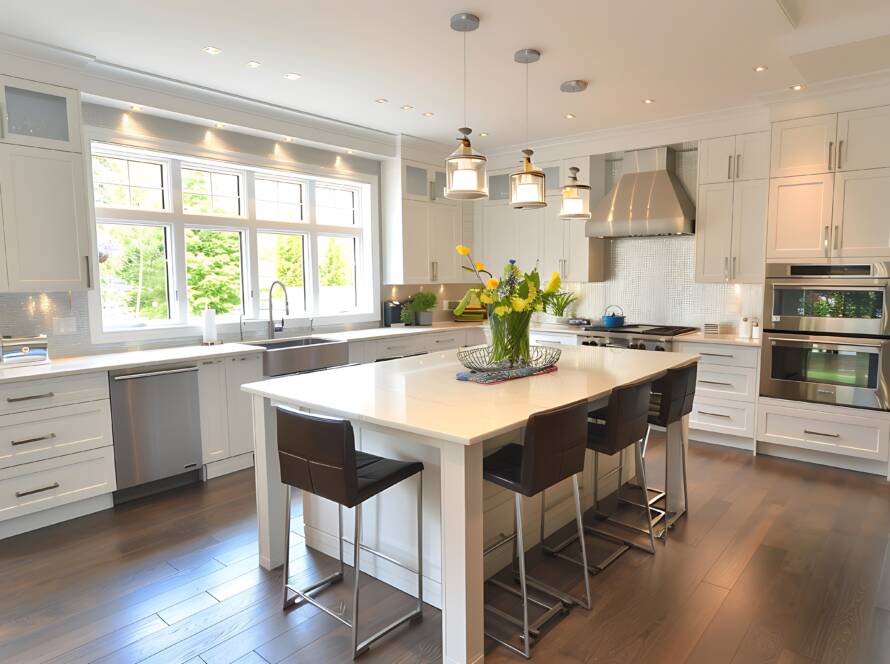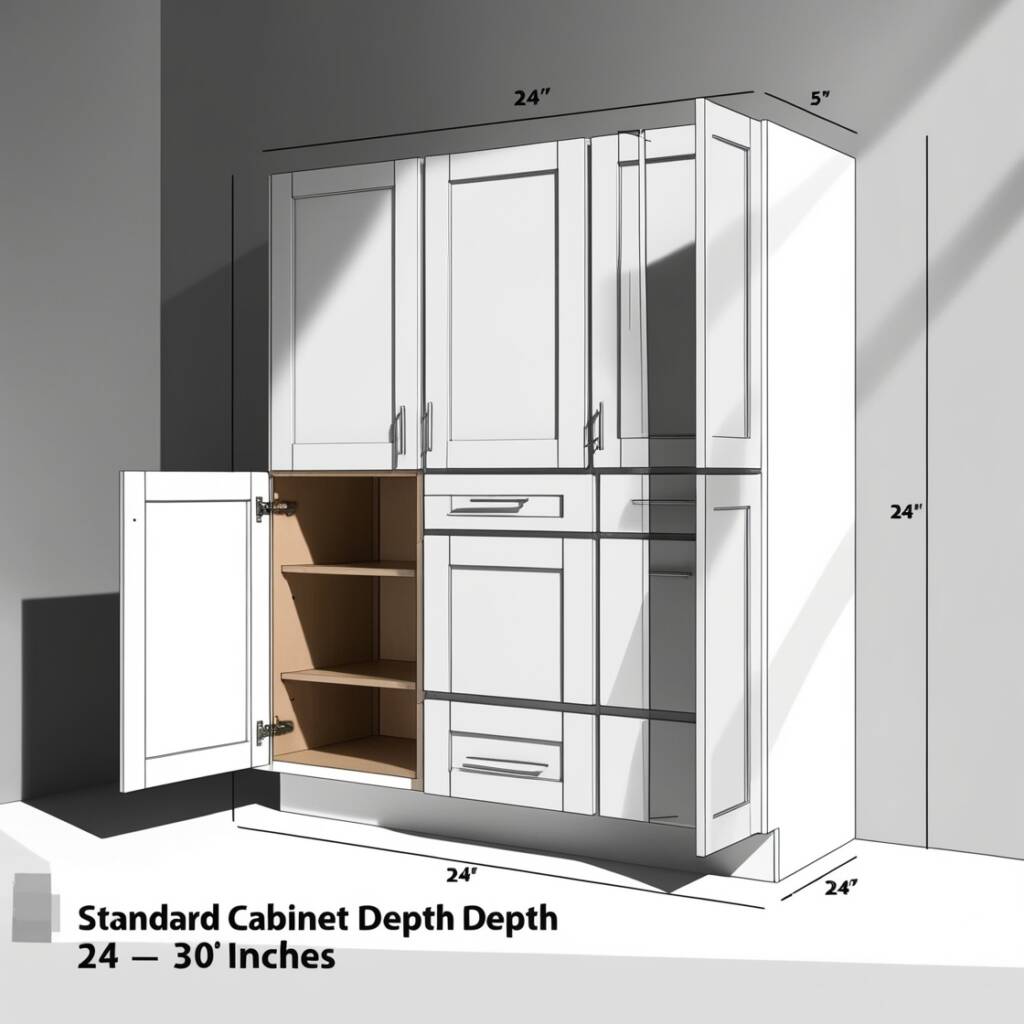
The Ultimate Resource for Standard Depth of Kitchens and Bathrooms
Understanding standard cabinet depth is important when one is trying to plan a kitchen or bathroom remodel to ensure that the space is both functional and aesthetically pleasing. Cabinet depth refers to the distance from the front to the back of a cabinet, and it plays a crucial role in both usability and the overall design of your space.
Whether it be designing a new kitchen or upgrading a bathroom, selecting the right depth of cabinets will make them efficient and proportional in size to the dimensions of your room. Here is a complete guide to understanding standard kitchen and bathroom cabinet depth, measuring them, and considerations when it comes to the depth selection for your custom cabinets.
What is Standard Cabinet Depth?
The standard dimensions for the front-to-back cabinet dimension define the typical cabinet depth. Such dimensions may vary according to the type of cabinet-for instance, kitchen, bathroom, or custom cabinetry-and whether it is a base or upper cabinet. This is directly related to the volume inside the cabinet and how that can work with or against other design elements in the space.
In the case of kitchens, standard base cabinets are 24 inches deep, while in the case of upper cabinets, they are usually 12 inches deep. For bathrooms, the depth of base cabinets usually falls in the range of 21 to 24 inches, though it may vary with different designs.
Standard Cabinet Depth in Kitchens
In kitchens, cabinets are designed with both functionality and aesthetics in mind. The standard cabinet depth for kitchen cabinets helps optimize storage while ensuring that the cabinets don’t protrude too far into the space.
- Base Cabinets
- The depth of base cabinets, which sit directly on the floor, typically measures 24 inches. This depth is considered the standard because it accommodates standard countertop sizes, creating a seamless look between the countertop and cabinets.
- The 24-inch depth provides ample storage space for pots, pans, dishes, and other kitchen essentials. It’s also deep enough to support most countertop appliances without compromising the room’s flow.
- Upper Cabinets
- Upper kitchen cabinets, which are mounted above the countertop, usually have a standard depth of 12 inches. This depth is ideal for holding smaller items like glasses, plates, or food storage containers.
- The shallower depth of upper cabinets allows for more accessible overhead storage while preventing them from overwhelming the visual space of the kitchen.
- Deep or Custom Cabinets
- In some cases, you may want to install deeper cabinets to maximize storage. Deep cabinets, often referred to as extended depth cabinets, can range from 27 to 30 inches deep. These are useful for storing larger kitchen items or maximizing under-counter space.
- Custom cabinets also allow for unique measurements to suit specific needs or preferences, such as deeper base cabinets for larger cookware or a more spacious pantry.
- Cabinet Depth for Islands and Peninsulas
- Kitchen islands and peninsulas may have a standard depth of 24 to 30 inches, depending on their intended use. For a more functional island, a depth of 30 inches may be chosen to accommodate additional storage, appliances, or seating.
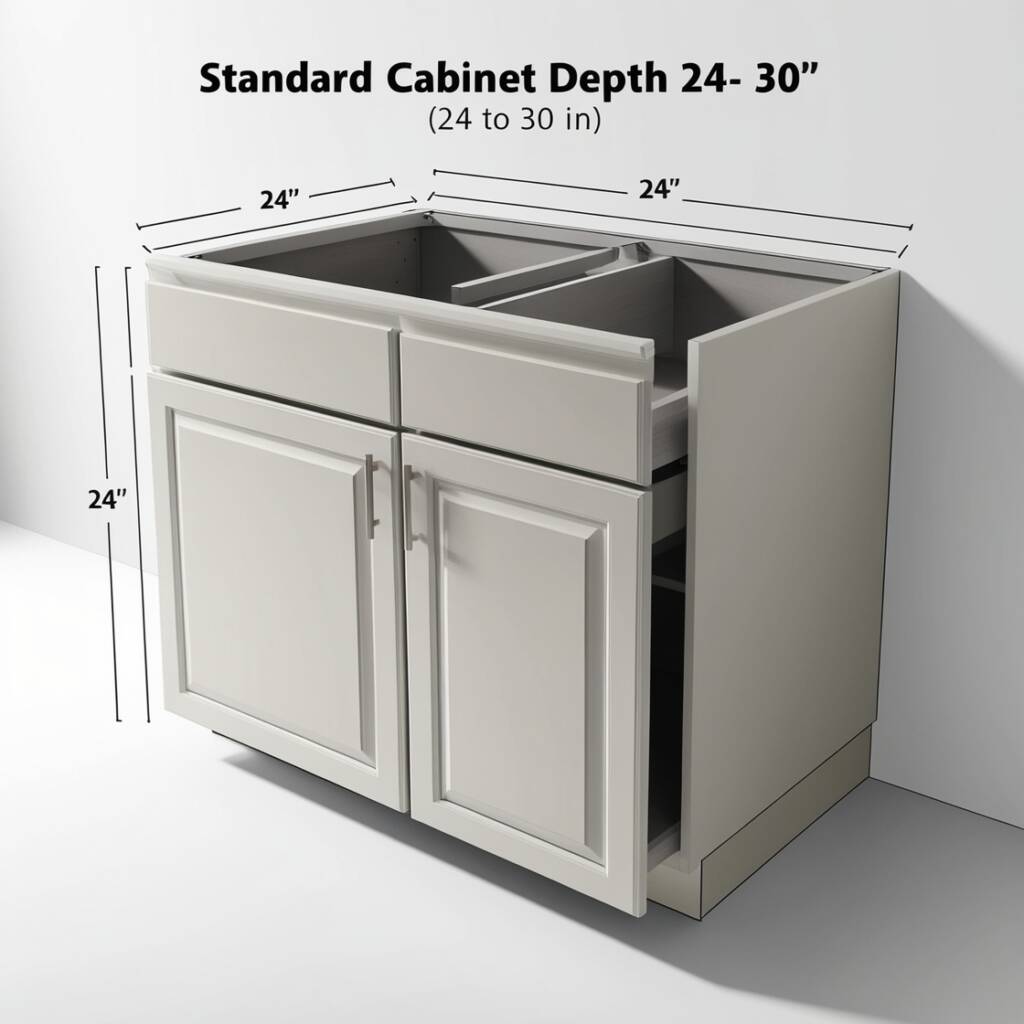
Standard Cabinet Depth in Bathrooms
While kitchen cabinets serve cooking and food storage needs, bathroom cabinets address toiletries, linens, and personal items. The depth of bathroom cabinets may differ a bit from the usual because they will be serving functions unlike those in kitchens.
- Base Bathroom Cabinets
- Standard base bathroom cabinets are normally 21 to 24 inches deep, somewhat shallower compared to those base cabinets in the kitchen. This makes sure the cabinet does not protrude too far into the bathroom and keeps everything in balance with other fixtures such as the sink or toilet.
- A depth of 24 inches provides ample storage for towels, toiletries, and cleaning supplies, while a shallower cabinet may be ideal for smaller bathrooms with limited space.
- Vanity Depth
- For bathroom vanities, the standard depth is usually 20 to 22 inches, with some custom options available depending on your needs. This depth is designed to accommodate sinks, faucets, and drawers while leaving enough room for comfortable movement within the bathroom.
- Wall-Mounted Cabinets
- Wall-mounted bathroom cabinets, often used for storing smaller items, have a standard depth of 12 to 14 inches. This depth allows for storage without taking up too much visual or physical space, perfect for smaller bathrooms.
How to Measure Cabinet Depth
Measuring cabinet depth accurately is essential when planning your kitchen or bathroom layout. Here’s a simple guide on how to measure cabinet depth:
- Base Cabinets:
- Measure from the front edge of the cabinet (where the doors or drawers are) to the back wall or the cabinet’s back edge.
- For standard base cabinets, this measurement will typically be 24 inches. Always account for any plumbing, electrical outlets, or obstructions that might affect the depth.
- Upper Cabinets:
- For upper cabinets, measure from the front edge of the cabinet to the back wall. The standard depth of 12 inches is ideal for most kitchens, but this can vary based on your needs and space.
- Bathroom Cabinets:
- In bathrooms, use the same method of measuring from the front edge to the back wall. For base cabinets, a depth of 21 to 24 inches works well in most cases, but again, your specific needs might require more customization.
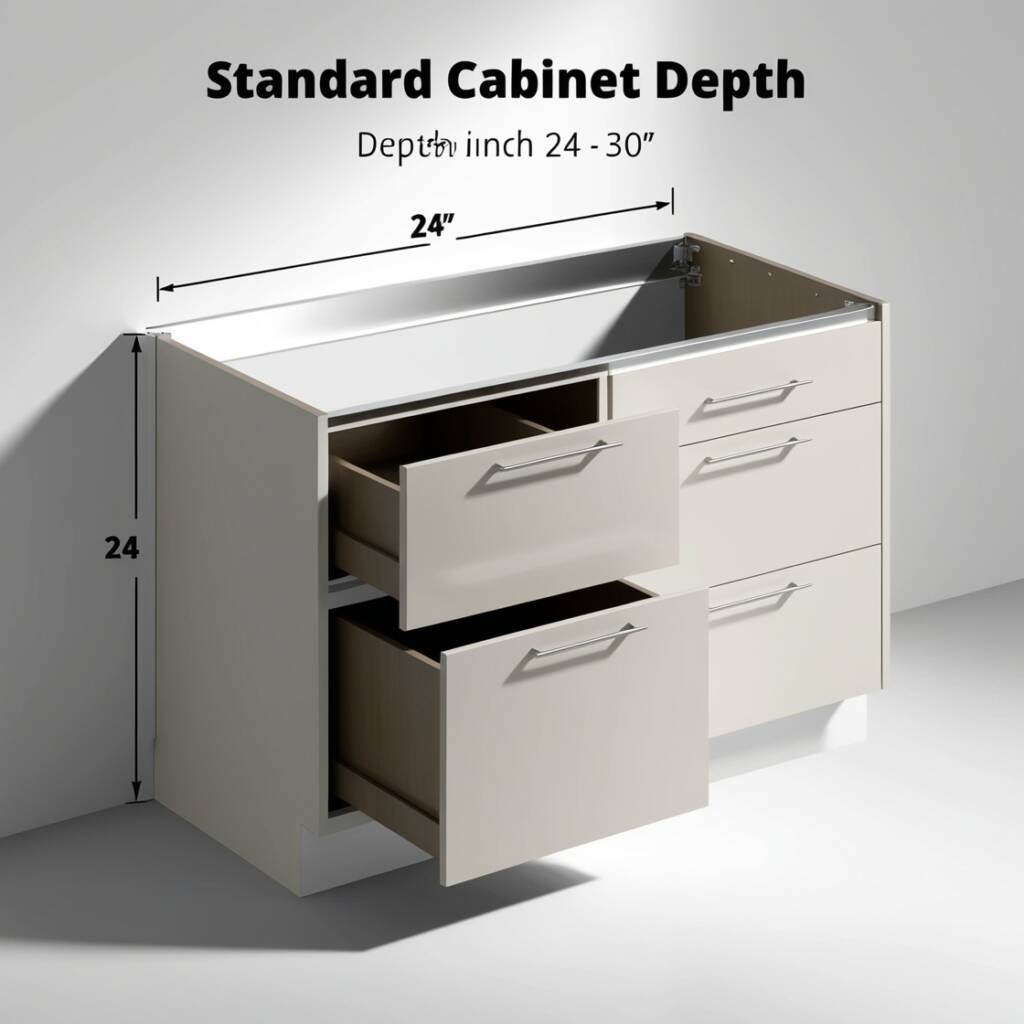
Factors to Consider When Choosing Cabinet Depth
While there are standard measurements for cabinet depth, there are several factors that influence how you should choose the depth for your kitchen or bathroom cabinets:
- Available Space
- The available space in your kitchen or bathroom will largely determine how deep your cabinets can be. In smaller rooms, shallower cabinets may be better suited to ensure that the space remains open and accessible.
- Functionality
- If you plan to store larger kitchen appliances, such as blenders, stand mixers, or pots, deeper base cabinets may be necessary. Similarly, in bathrooms, deeper vanities may be needed to store bulky toiletries or cleaning products.
- Aesthetics
- The aesthetic appeal of cabinet depth should also be considered. Deeper cabinets can provide a more robust and filled-out look in the kitchen, while shallower cabinets in bathrooms contribute to a cleaner, more spacious appearance.
- Accessibility and Ergonomics
- Accessibility is key when choosing cabinet depth. Deeper cabinets can store more, but they can also make it difficult to reach items stored at the back. Pull-out shelves, lazy Susans, and deep drawers can make accessing these items easier and more efficient.
- Design Style
- The depth of your cabinets should also match the overall design style of your kitchen or bathroom. Sleek, minimalist spaces might benefit from shallow cabinets, while more traditional or rustic designs can support deeper, more substantial cabinetry.
The Standard Cabinet Depth for Kitchens
Understanding the typical kitchen and bathroom cabinet depth is vital for your design and remodeling process. Standard dimensions-24″ for base and 12″ for the upper cabinetry-assist in function and usability of both the kitchen and the bathroom areas. However, tailoring your cabinet depth to the size of the room, your needs for storage, and the look you want can bring more optimization and comfort into your layout. Considering space, functionality, accessibility, and aesthetics, as we did, will help in deciding on the perfect depth for your cabinets.
For those looking to explore further ideas and inspirations for optimizing cabinet design in kitchens and bathrooms, Atlantis Cabinet offers a range of resources to guide you. Visit Atlantis Cabinet’s blog for expert insights, custom design solutions, and tips to make your remodeling journey seamless and stylish.

